Cording is evil.
After pintucks, and the Briar Rose Corset, cording makes #3 evilness.
I’m making an 1890s corded corset. It’s based on a pattern in Jill Salen’s Corsets: Historical Patterns and Techniques.
The pattern is kinda weird and insane. Look at my pattern pieces:
Starting from the centre back on the right, it looks totally normal. Basic princess seam, basic side back princess seam, basic side front princess seam, and then you have your….what the heck is that!?!
That, dear readers, is the front piece, with a set in bust.
The problem with the set in bust is that 1) it gets set into a 3.5cm opening in the front piece (and I don’t know if you have ever measured one breast, but mine isn’t 3.5cm across!), 2) the original corset was sized for someone very short, with a very large cup size, so needed a lot of resizing, 3), resizing bust cups is horrible and tricky and 4) once you have figured out all the fitting issues, actually setting in a double bust inset isn’t easy.
But before I get to the setting in the bust bit, I had to sew the aforementioned evil cording.
But first I should tell you about fabric.
I’m using a gorgeous black silk satin recycled from an obi for the outer of my corset, a dark pink vintage cotton for my lining, and obi lining cotton for the interior support.
I sewed my cording between the black silk and the stiff obi cotton.
Basically every single piece of the corset excepting the front piece is fully corded. That’s a LOT of cording. My corset is corrugated.
To sew the cording, I marked the centre cording line in each pattern piece with chalk, and then sewed a line of stitching along that line. Then I used the zipper foot to sew a cord snuggly up against the line of stitching to start my cording.
Additional lines of cording get smashed up against the started cording line. I would maneuver the fabric with my left hand, and use my right index fingernail to push the cord up against the stitching and press in a crease to sew along, keeping the cording nice and tight and even.
And every three cording lines or so I would sigh and come up with a new creative not-actually-a-swear word and wonder why I did this to myself.
But for all that evilness, the corset is almost done, so I’ll show you more progress pictures in just a day or two!

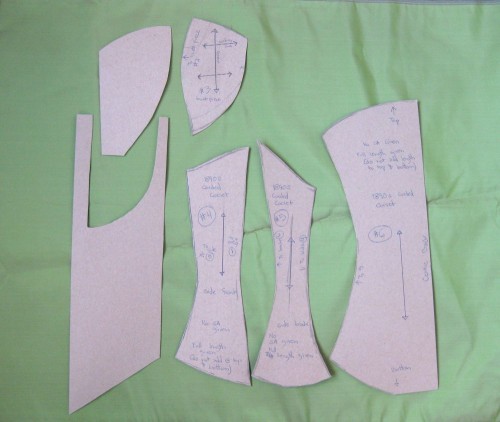


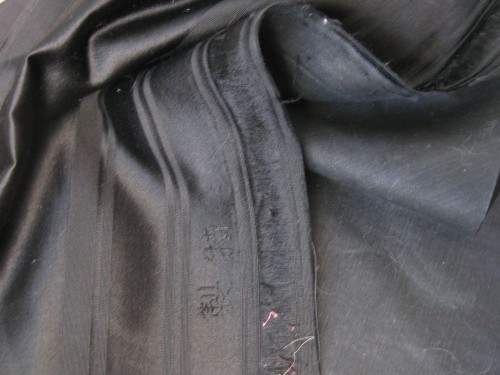
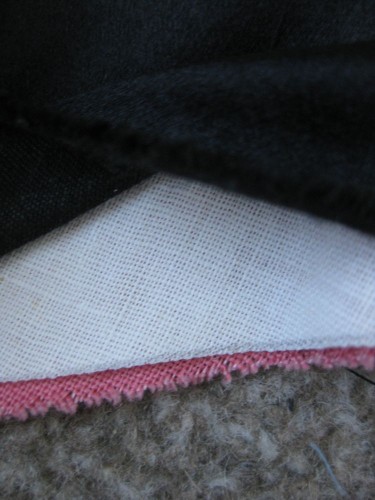
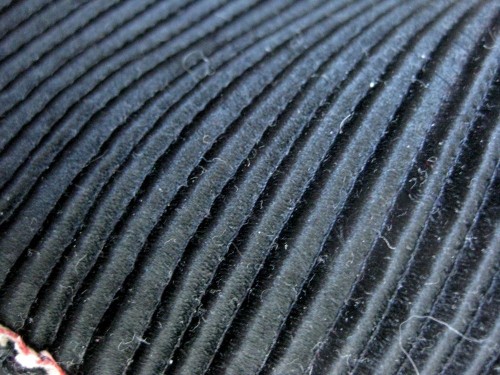

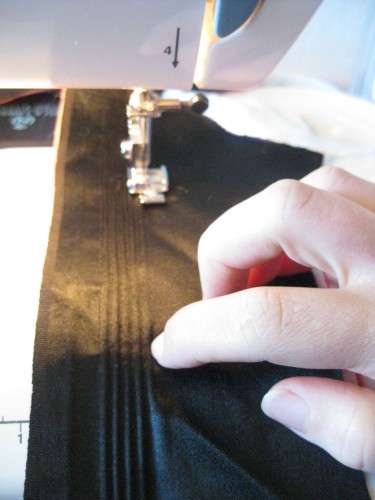
That is going to be *gorgeous*!
This sort of cording really looks evil.
The sort of cording I have tried so far – this: http://www.jennylafleur.com/study/runners.htm – is easy peasy in comparison. I didn’t do the fabric-opening part yet, so I didn’t even use florist wire, just a hairpin. I’ll try to stick to that even when my cording channels don’t run to the edge of the fabric. The hairpin was practical and at hand.
But this… whew, that’s one crazy pattern! I really wonder how that works on the body.
THAT sort of cording does not look easy! It looks (just like she says) “fiddly and time consuming”. Good for cording patterns that are really irregular and broken like Romantic corded corsets, but I’m still going to stick to this technique for this type of cording!
I will let you know about how it works on the body.
It was easy, really. Her stays might be more fiddly (I’m going to find out soon…), but I still think sewing the chanels first saves a lot of trouble (and Stella says so too!).
Speaking of crazy patterns, I got reminded of my medieval sleeve experiments. That was one crazy pattern, too. Remembering that makes me realise that there’s probably some sort of great importance to this pattern, I just don’t see it on first glance.
OK, I can now officially report that I tried the other method, and it is not any harder than my method, but nor is it faster and easier. In addition, it doesn’t make nearly as nice, or as strong cording, as the method I use. You simply can’t get the channels as tight as with a machine because the cord has to be doubled to draw through. And the pre-sewn channels mean that the cording bumps out on both sides of the fabric, which isn’t as comfortable for a corset. I was so unhappy with the pre-sewn and then drawn-through cording that after investing an hour and a half to do both bust pieces, I ripped out all the stitching and cording and am re-doing it by machine, because the end result is so much better.
I think that using the drawn-through method may be why Stella has had trouble getting cording to be strong enough to support her bust – it creates a much weaker cording than the machine method.
I can see where the pre-sewn channels and then needle to draw-through method is a real advantage when doing the complicated cording patterns on Romantic Era corsets, but it’s definitely not right for a late Victorian corsets. If I were doing pre 1860s cording I would use the needle drawn-through cording, but for anything later than that I am going to use my method, which is more accurate for 1870s onward cording anyway.
Thank you for the learned input. 🙂
I would never have know to check it out if you haven’t commented!
Yes, cording is evil, but it’s looking amazing!
I recommend you try cording the way Hana-Marmota suggests. It’s much, much easier. I always sew the channel first and insert a doubled length of cord with a long needle made from wire. I love corded corsets and have made a few, but I’ve always run up against a problem: cording alone isn’t enough to support large boobs. Yet you say this pattern was made for a lady with large boobs, so perhaps putting the cording horizontally across the cups is the way to do it. I’ve always run the cords top to bottom and have had to use spring steel or heavy duty cable ties in the front. Definitely something to try! Thanks so much for bringing this to my attention!
For support in the bust, this also has THREE bones that run across the bust, and bones on either side as well, so any bust will be well held in. I’m considering not running the bones all the way across the bust for me, because the cording does such a good job, and I need so little support!
I’ll give the other type of cording a try, but I’m dubious.
That bust looks very tricky, but interesting, especially with all the cording and boning.
Do the pieces shrink a lot in size, with all that cording?
The top pieces did shrink with the cording, but I anticipated that and cut them bigger.
I so love recycling lovely fabric, but I’ve never even attempted anything this awesome.
For some machines they sell a special foot that I think would help with this process. It definitely helps in making and attaching piping – now it takes me 1/4 the time it would normally take me for both processes. For my machine, a Bernina, it’s foot #30-33. See what the foot looks like and their little video tutorial here: http://www.berninausa.com/product_detail-n25-i41-sUS.html
I haven’t tried it yet for this purpose, but it is an amazing (sort of life changing) foot! 🙂
I think that you could also use it to make the cording the same way that you are showing in your pictures (and not like in the video if you don’t like that way) but the little grooves in this foot hold the cord in place exactly where it needs to be better than pushing the cord up against the other with your finger.
I own that foot, and use it all the time. It is fabulous for cording if the cords aren’t smashed right up against each other, but it doesn’t work when they are because it has to sit on top of the other cords 🙁
But thank you for the suggesting!